#textile as a medium
Explore tagged Tumblr posts
Text
#poll blog#random polls#silly polls#stupid polls#polls#silly poll#tumblr polls#poll#art poll#language poll#language#art#languages#the arts#foreign languages#art mediums#visual art#performance art#textile arts#music#português#español#français#普通话#русский язык#हिन्दी#artists on tumblr#dance
243 notes
·
View notes
Text
I have been thinking about the costuming in Willow a lot, and yes this is for fanfiction reasons but it's also just for fun. As background, my non-fandom hobbies are mostly textile based: I sew garments and teach sewing classes, I'm an experienced knitter and handspinner and I've started to dabble in wool processing from fleece and four-shaft weaving.
So once I get into a Textile Puzzle Hole I can go pretty deep, and this is a fun and important part of understanding the worldbuilding for me.
Because they're doing a thing with Willow that - I actually really enjoy. It's not "classic fantasy" in the sense that it's not period-appropriate or of a specific era that we'd recognize. They're also clearly trying to call back to the 80s roots of the original film with some of the design choices; mostly the elements of armor and clothing that they're pulling from traditional martial arts clothing and the existence of Fun Fantasy Denim.
A lot of my thoughts aren't necessarily about critique, but more about trying to put together a cohesive rubric for myself as to what the costuming aesthetic is. Because it's not "anything goes," it's got a specific vibe and a clear voice and I want to "get it" more for my own writing and for my own understanding.
I think the two rules that I've drilled down so far are:
Textiles As Artisan Material (all-handmade, no fantasy spandex)
Function Over Form
1. Textiles As Artisan Material So to get into this a little, I want to get into the idea of how textiles are made because for me I'm In Deep and know a lot about the raw material to cloth to garment process but the average person does not. (I will say, I'm excepting the Cuirass from all of this - we know metatextually that it's a 3d printed stretch fabric bodysuit; it's also magic so it doesn't count.)
So, the average person is used to textile production that is predicated on post-industrial-revolution technology. Meaning:
power-driven machines for weaving and spinning
computer technology available in spinning and weaving machinery to allow for easy production of highly complex cloth structures and patterning
overabundance and artificially low costs of raw materials
When you are thinking of fabric (and I'd include cloth and leather here but not metal armor) as a skilled artisan material, understanding the reasoning for, for instance, Jade having one shirt for the entire series involves understanding what steps are involved. Then, we can understand how many human beings are involved in fabric and therefore garment production and also how many people need to get paid along the way. A piece of cloth entirely handmade for a garment would involve:
a producer to grow the textile fiber (cotton, flax, wool, hide for leather)
skilled artisans to process the fiber (washing, preparing for spinning which could include combing/carding wool, retting flax, etc, leather tanning)
skilled artisans to add dye. This can be done at the stage of prepared fiber, finished thread/yarn, or finished cloth. In a real-world/modern context, this would have significant impact on the cost of cloth. Certain colours (reds, purples) are much harder to dye true than others or require more expensive dyestuff.
skilled spinners to turn the fiber into fine threads for weaving - depending on the fineness needed for the specific weave of the cloth this could be weeks to months of work. Thinner threads will take more time but have more drape and be less stiff as a cloth, so you'd need thin threads for next-to-skin garments like undershirts, and for fine fabrics in things like dresses or fancy formalware
weavers to weave the threads into cloth. Again, the timing here would depend on the type of thread being used but it would also depend on whether or not there are any woven-in embellishments as components of the cloth. Basic cloth in plain weave would take time but not a lot of extra skill; twills or patterning require more time and weaving skill.
embroiderers to add any embellishments either to the base cloth or to the finished garment
tailors and seamstresses to make garments to measure, which would involve cutting any pieces out of the finished cloth and turning it into a garment the correct size for the wearer. If we are assuming that the mechanical sewing machine has not been invented, then garments would be sewn by hand.
handsewing a correctly finished garment involves more than just tacking the pieces together; seam finishes so that the cloth doesn't unravel often require going over the same seam line one or more times. The labour hours in this step cannot be overstated.
metalworkers or other craftspeople to make fastenings and finishings: buttons, toggles, grommets on lacing that weren't handsewn, etc.
leather garments would be made by a separate type of textile worker, since leatherwork requires different tools and a different skillset to successfully construct garments.
So for a basic garment we're looking at needing to pay six separate types of skilled artisans for their work, up to six or seven if it's a garment with elaborate fittings and/or finishing such as buttons or metal fasteners.
The textile economy is relevant here because it is going to translate directly into style. Cutting fabric into patterned shapes leaves waste; this is fine if you're using mass-produced fabric that you can easily afford to replace but if cloth is the 10/10 most precious thing in your garment, you're going to try to cut it into as low-waste a design as possible. It might also lead to less fussy fitting, so that garments are adjustable and can be used by a person for much longer.
It also translates into textile types. Prior to the advent of mechanical knitting machines, any knit (stretch) fabrics would be hand knit. If you have ever tried knitting yourself, you understand that knitting with thin thread takes more time, and therefore more labour hours.
What this means for clothing in-universe on Willow is:
almost entirely woven fabrics, with the exception of handknitting (see: Elora’s scarf-shawl)
this likely does translate into undergarments; I've been looking at regency and late-Victorian era examples to get my head around. The modern bra and panty set is heavily heavily dependent on not just machine knit fabric but also a TON of petroleum-based synthetic textiles that cannot be produced without modern post-industrial means.
fastened using items that can be handmade! Buttons, toggles, clasps, ties or belts for the most part, with the occasional Fantasy Rivet or Fantasy Grommet.
precious! so precious! Expensive to produce and also worth caring for; we see some examples of visible mending in-show and that would have been the standard for everyone with the exception of Kit and Airk.
2. Function Over Form So this is maybe something that I only think about because I sew, but the modern eye is really used to equating and understanding "woven" fabrics and "stretch woven" fabrics as equivalent. Jeans are the easiest example to think about: they're made with denim, but in things like skinny jeans that denim is usually blended with some kind of spandex. Typical woven fabric doesn't stretch in either direction in a meaningful way; stretch-woven fabrics do so because of the synthetic textile content.
So a lot of the design choices that we see in the show really have to take into account that those textiles won't stretch with movement, and that the wearers need to be able to swordfight:
larger, baggier shirts with cuffs or vests rather than more fitted shirts, to allow for full movement at the elbow and shoulder
trousers that have a bit of extra wearing ease at the hip and thigh, so that when the wearer sits or squats there is room for the change in their body shape with these positions
there are a couple of GREAT leather jackets (Kit's in the early season especially), but if you look closely there's actually a grommet-and-lacing system to attach the sleeve head to the body, so that the shoulder still moves. So clever!
Anyway I have been having a lot of fun thinking about this and deconstructing the garments further. Thinking more about the costuming helps me find the worldbuilding details that make it easy for me to write, and I’d love to chat about this lots and lots! I do have some screenshot receipts for this; I didn’t include them because I mostly just wanted to write and not do ~graphic design today.
#grouchy aunt j's fantasy textile opinions#willow: medium powerful magic once adjusted for inflation#willow 2022#fibre arts are the best arts
67 notes
·
View notes
Text

Bronica ETRS with Zenzanon 50mm f2.8 lens, shot on Kentmere 100 and developed with Ilford Ilfosol 3
#photography#film photography#ishootfilm#analog photography#filmisnotdead#b&w photography#120 film#medium format#textile industry#industrial#industrial photography#textiles#bronica etrs#bronica#kentmere pan 100
5 notes
·
View notes
Text
Crocheting, knitting, textile art is so time consuming. But!!! BUT!!! It tells me that things I care about will take time and effort. Things I want, things I love, need dedicated. They need me to care enough about them to set aside some time for them.
I cannot want them to become faster. I am not losing time. Yes the bag I crocheted took a week but it is beautiful and it is well made. I can put things in it. It is sturdy and I made it. I even used two colors AND made it slightly fancy by adding two granny squares in it for pattern.
I had to figure out a lot of stuff on my own!! I had to frog a bunch of it too!!
But!!! I made it.
ALSO I'M SUPER ELATED WILL HOW IT TURNED OUT AND I FEEL LIKE I LEVELED UP IN MY CRAFT
So yeah
3 notes
·
View notes
Text
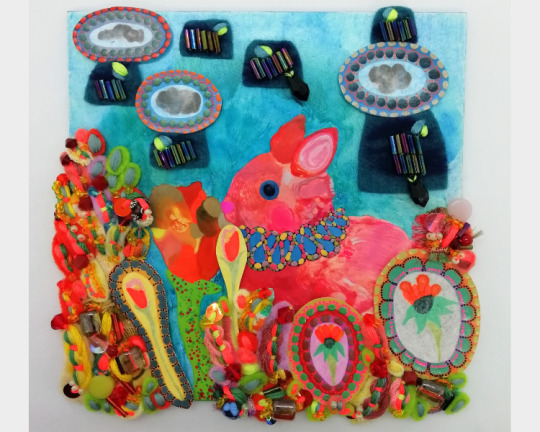



"These flowers smell so good! It must be the pretty raindrops Feeding them magick and wonder. I want to stay in this place For a very long time."
~ Says Bonnie, the pink flower bug.
#pink bunny#rabbit art#textile art#small art blog#small painting#artists on tumblr#modern embroidery#beadwork#flora and fauna#slow stitching#wall decor#colourful#mixed medium
7 notes
·
View notes
Text
The thing is, we need to be aware of the intended function of things, re: art. Some genre conventions exist solely to express or exaggerate an idea or feeling. Some ways of writing or performing exist primarily for emotional catharsis. Dark or absurdist humor is a way to deal with serious topics without having to put yourself directly in the middle of them. The songs in musicals are meant to be a communication of ideas that are too complicated and emotionally intense to remain contained in spoken word. Things like twelve-tone music/experimental opera are meant to reconceptualize how we think about the structure of Classical music and the aesthetic things we've come to expect from it. Gritty or serious deconstructions are usually meant to make us re-examine literary conventions, either as a thought exercise or to make some sort of statement about the world. It's okay if something doesn't work for you, but JESUS FUCKING CHRIST, you all have got to stop acting like something not working for you makes it inherently meaningless or artistically bankrupt or "immature" or "stupid" or "needlessly edgy" or whatever the fuck else people keep trying to claim.
#yes actually this IS a targeted post#the person will not ever actually see it but this block of text IS in response to something I saw#(okay to several things I saw)#like I really. REALLY. try not to get Specific™ and only be petty in generic terms but I am AT! MY WIT'S END!!!!#'this medium/art style is inherently cRiNgE' nobody fucking asked you!!!!!#(keeping this more in the realm of writing/music because that's what I have personal experience with. I am not qualified to have an#in-depth discussion of the specifics of something like textiles or fiber arts or visual art)#(but I hate when people do this about THOSE forms of art too)
2 notes
·
View notes
Text
I finished my yuri skirt

it is of course my Girls. made it out of an old skirt I've had since actual middle school and never wore because it was a midi skirt and I don't wear midi skirts. she was just going to be cabbage but I randomly got inspired at like 10:30pm last night and now we have this
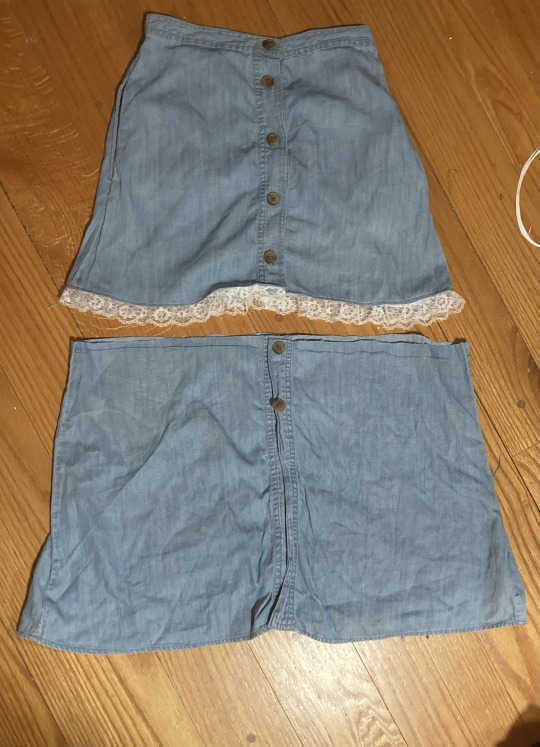
this is how much I severed that's going back in the cabbage drawer
#shaman king#iron maiden jeanne#tamamura tamao#tamajeanne#I actually used textile medium this time this might be machine washable
8 notes
·
View notes
Text

@byanyan requested a starter:
" i think this box has the best colours. " he pushes the box of oil pastilles towards byan , a make shift peace offering despite the two having never interacted before. its full of pinks, purples and the odd blue - worlds away from the stack of broken neutral sticks in boxes around the table where byan seems to be sat alone. he chooses to ignore the name that byan had made for themselves, a troublemaker, amongst other names uttered by students; " if you want it? they fit your vibe. "
#↳ FILE : // joonki → ic.#hear me out ... byans fashion design at college verse#joonki does fine art so its not EXTREMELY out there that they may be in some sort of art based class together#maybe some sort of textiles and mediums class#i did a SINGLE college art class in america and we did nothing for like five hours every week so who knows#byanyan#sharing crayons like they r in kindergarten <3
4 notes
·
View notes
Text
This may officially be the most self-indulgent fic I’ve written in... *checks notes* a while, by virtue of containing both shameless hypermobility projection and Knitting Versus Crochet Discussions.
(Though I’m writing it from the perspective of a knitter intimidated by crochet when I learned the other way around.)
#at some point I'm going to work into a fic the Great Crocheting Socks Debate#it's merely a matter of figuring out which characters would take which side#(which is not necessarily related to their medium of choice)#(but more where they weigh in on the artistry and challenge of it vs the practicality. or their own commitment to textile chaos.)#this one however will feature the Sweater Curse#crafting with regalli#writing with regalli
3 notes
·
View notes
Text
Orange Spice- Magick- Nishante- Salamander Art- Nisha Designs
Art Name: Orange spice. Medium: color pencils. Size: 5″ x 4″. Price: $25+ shipping. [Shipping cost depends where we are shipping to.] This ships from the USA. Payment: Once we receive your shipping address we will send you the final cost and invoice. Payment choices paypal, square, venmo. However you choose to pay. Once payment is received in full we will send you the piece with tracking…
#abstract art#ART#artiste#color pencils#mediums#orange spice magick#painting#textile designer#textilea
0 notes
Note
i'm rewatching Willow and i still can't comprehend what exactly Elora's weird wrap shawl thing with a hood is. or why it is. why is she wearing THE most impractical garment i've ever laid eyes upon. as the resident Willow textiles expert, what are your thoughts?
Oh I actually fully know the answer to this question!
One: if you would like to better understand the garment construction, there's a detailed knitting pattern with a schematic here. The in-show garment is definitely knitted, but if you're a crocheter this person's got you. What you need to understand is that if there is a thing that has a fandom, and in that thing there is a handknitted garment, viewers who knit have started mentally deconstructing it immediately.
BASICALLY both of these garments are a very long scarf, and then you make a big keyhole, and then more scarf, a second keyhole, then even more scarf. After you have the world's most giant scarf, you add a hood in between the keyholes. The way it's actually worn is with each hole as a sleeve; the trailing ends are then crossed in front of the body and tucked through the sleeves to secure them, which creates the crossed-bodice covering effect.
Two, in terms of practicality, I endured two years of The Improbably Clean White Mother Confesssor Traveling Dress so I know the real answer is that trailing ground-level things look really cool and High Fantasy Femme Heroine on-camera.
However, one of my favourite things to do with this show is take costume elements and read them in-character, because I think it adds another little layer of worldbuilding flavour that really pleases me. So in my heart of hearts:
Elora knit that scarf herself. Or maybe she had help with it, maybe she started knitting it and got frustrated and lost track of rows and couldn't bring herself to rip back, and someone else finished it for her. Either way that scarf was made by hand and it took a long time and so much care. I like to think about Elora packing for a long and dangerous journey and bringing something that makes her feel a little extra loved.
Assuming that scarf is made of wool (which again: idk what it's made of for costuming-sake but in-universe it would be) it is going to be warm as shit. A lovely, densely-knitted wool cape and hood, with the construction designed to allow it to wrap around the whole upper body, would actually be extremely practical for cold, damp nights and staying warm while keeping her arms free to ride or cook. The longer tails you could argue might be practical for wrapping more of the torso or using as a pillow on long nights.
You could also make the case that, while the other members of the party are outfitted with capes and other warm garments, Elora as a kitchen maid might not have had access to something like that. I've talked about this more in my fantasy textile post but basically: woven wool textiles are expensive. Something like that scarf could well be the warmest thing Elora owned, and might have been practical to bring from that perspective as well.
Anyway I love that scarf to bits, it is not something I'll ever make myself but I think it's gorgeous and incredibly distinctive, and the odd construction adds a great bit of Fantasy Je Ne Sais Quoi that is really great.
#grouchy aunt j's willow costume nerd hour#grouchy aunt j's fantasy textile opinions#elora danan: princess princess ever after#willow: medium powerful magic once adjusted for inflation
38 notes
·
View notes
Text

Bronica ETRS with Zenzanon 50mm f2.8 lens, shot on Kodak Portra 400
#photography#film photography#ishootfilm#analog photography#filmisnotdead#colour photography#medium format#bronica etrs#etrs#industrial#industrial photography#loom weaving#loom#textile industry#120 film#kodak portra 400
3 notes
·
View notes
Text
Recently at a visit at the Barbican art gallery in London. ‘Unravel’ The Power and Politics of Textiles in Art.
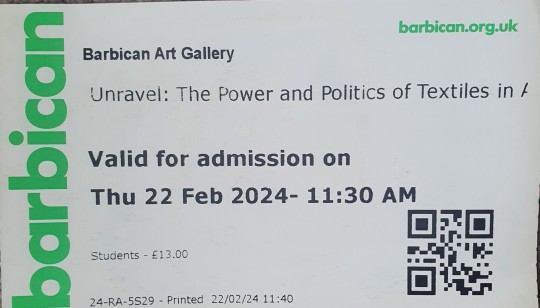
I came across an artist Ghada Amer. I liked the use of thread she use as a medium to paint. I have explored painting with threads in my concept of movement and it was exciting to see an artist use it in a similar way.
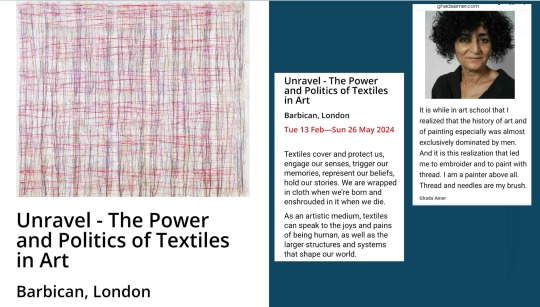
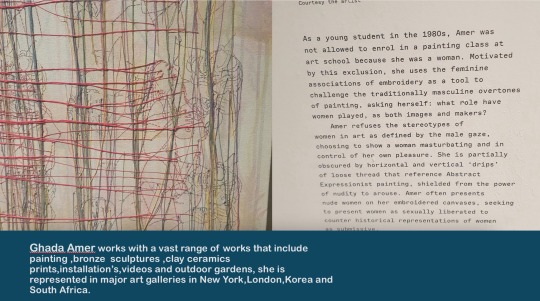
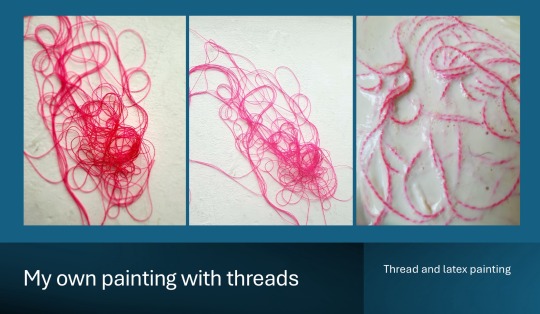
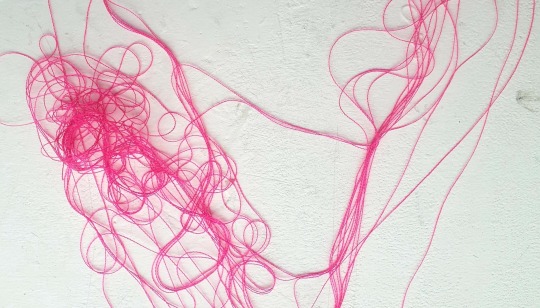
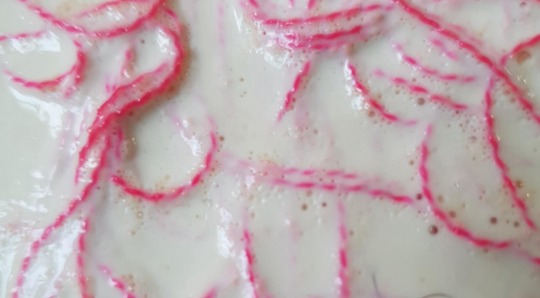
Painting with pink threads and latex as a medium. I feel the liquid of the latex gives a feeling of movement , although it is dry it looks wet with bubbles in it. The movement of the threads although are static I feel they are almost moving around the latex.
#Ghada Amer#Barcbican#Barciban London#unravel the power and politics in Textiles in art#painting with other mediums
1 note
·
View note
Text
ive said this before but so much of what Retvrn Freaks glorify in early modern european art are just components inherent to the mediums being used at the time as opposed to like. an example of heightened skill that has been supposedly Lost in these degenerate times.... oil paint just looks like that. its very tonal and rich and even an artist with mediocre rendering skills will have their rendering skills improved by painting in oil. old oil paintings took years to complete not because the artists doing them were very skilled but because oil takes months to dry and they built up subtle washes over dried paint. tracing was also commonly utilized during that time period, and artists also often had small armies of apprentices who would do the hard work for them with no credit. these huge highly tonal oil paintings become significantly less impressive when you actually learn about their context.
#this isnt to like. diss or hate on oil painters or even all art made in europe during that time period#there are lots of great artists from that time period#but i also dont think that sort of art is more valuable than any other artistic movement#and i think posing these two very culturally european mediums as like the Pinnacle of art is stupid#another issue which isnt really to do with what im talking about here is like cultural ideals surrounding art...#if youre educated in a western tradition youre sort of encouraged to idolize realism and its associated artistic skills#eg: (anatomical accuracy - rendering skills - perspective)#and then favor mediums which lend better to those ideals. and then when you look at art from other cultural traditions#where the focus may have been on something different like color or symbol or narrative over realism you sort of see them as “lesser”#or theres the assumption that the artists who made those pieces were worse at art or unable to make highly realistic pieces#which is of course nonsense and also often racist (eg. colonizers in west africa assuming there must have been a greek colony#there because they found realistic statues and couldnt understand how people who currently made more stylized art could have made them)#but you even see this in popular assumption about european art pre-enlightenment too#like all those memes making fun of medieval manuscript faces. they drew like that because the narrative was more important than the realism#because the artists drawing them were basically illustrating bible stories#medium at hand also has a big hand to play here. art made for woodcut is gonna look different to art made for fabric#and oil paints arent uniquely european but they arent as widespread as clay or textile
0 notes
Text
…
#okay I’ve been ~ruminating~ on ai art a lot recently and trying to place it#bc I do actually spend a lot of my life rotating the concept of art in my mind like a bug#and I think it’s fundamentally a personal experience but also not something I have an extended essay worth of stuff to confidently say#which is why this is going in the tags lmao#but for me a lot of art appreciation and understanding comes from getting the medium#I became a lot more fascinated and moved by oil paintings when I started oil painting myself#I love textile art because I make a lot of it so I see it through that lens#and ai art falls in a similar vein as modern poetry I think#a lot of it is this weird low effort splodge of shapes and colors and hitting the enter key randomly#like okay I guess….idk what you want me to do with thi?#anyways I think secret horses is a good example. like do something with the medium to create a cool result#then it registers as more than just some limp blackout poetry
1 note
·
View note
Photo

Transitional Family Room - Family Room Inspiration for a mid-sized transitional loft-style medium tone wood floor family room remodel with blue walls, a standard fireplace, a concrete fireplace and a wall-mounted tv
#blue and green throw pillows#brick fireplace surround#wooden side tables and sideboard#chevron printed textiles#loft-style#gray upholstered sofa#medium colored hardwood floors
0 notes